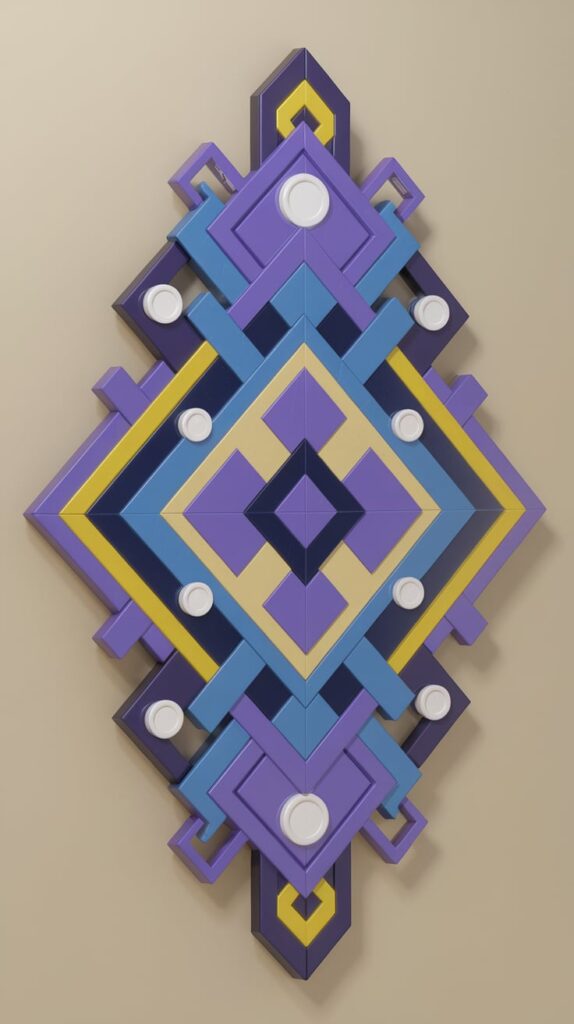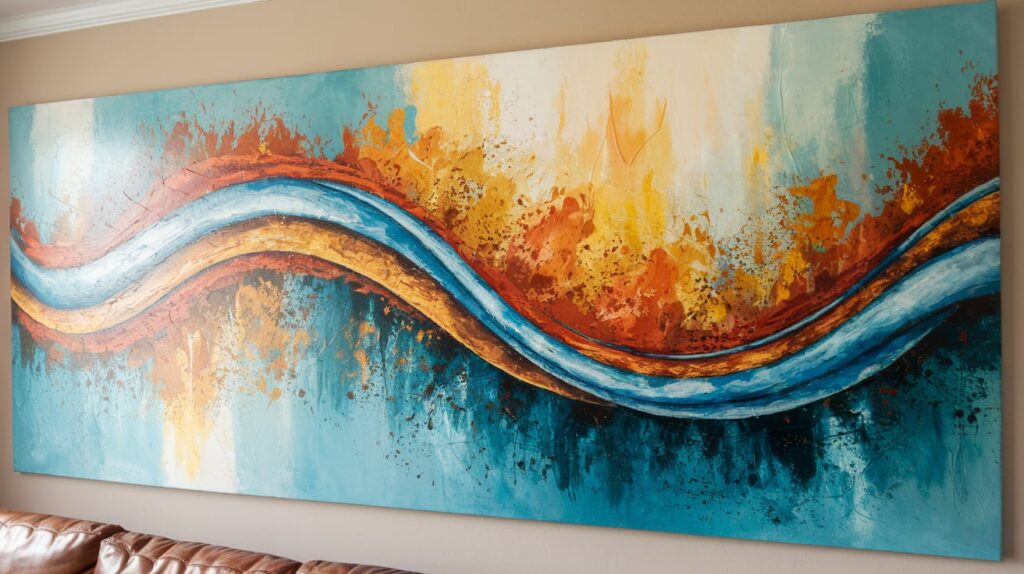How to Choose the Perfect Wall Art for Living Room ?

Imagine walking into your living room, where every wall tells a story. A piece of art that not only enhances the space. But reflects your personality. Wall art has the power to transform an ordinary room into an extraordinary space. Wall art for the living room is more than just decoration. It is the finishing touch that ties the room together. It sets the tone, creates focal points, and can dramatically influence the mood and style of the space.
In this guide, we’ll explore how to choose the perfect wall art for your living room. Right from assessing your space and selecting the right size to coordinating colors and exploring different types of wall art.
Understanding Your Space to Make Wall Art for Living Room
Assessing Your Living Room
Before choosing wall art, it’s essential to evaluate your space. Consider the layout, the size of your walls, and the overall aesthetic of your living room. A small room with limited wall space might benefit from a minimalistic approach. While a spacious area could allow for a bold, large-scale piece. Take note of existing furniture and decorative elements. To ensure harmony between your wall art and the rest of the room.
Choosing the Right Size
When selecting wall art for your living room, size matters. A piece that’s too small can feel lost, while something too large can overwhelm the space. As a general rule, aim for art that covers 60-75% of the wall space above furniture, leaving room around it to breathe. For example, above a sofa, a horizontally aligned piece or a gallery of smaller works might be the perfect fit.
Color Coordination
The colors in your wall art should complement the existing palette in your living room. If your room features neutral tones, bold, vibrant artwork can provide a stunning contrast. Alternatively, if your living room is already rich in color. Choose pieces with more muted or complementary tones to create a cohesive look. Matching or accenting with your room’s primary and secondary colors helps tie the room together seamlessly.
Types of Wall Art for Living Room
Paintings and Prints
Whether you prefer traditional oil paintings, modern abstract works, or limited-edition prints. Paintings are a timeless option for wall art in your living room. Prints are more affordable and versatile, allowing you to change them out as your style evolves. Popular choices include landscapes, portraits, and geometric abstracts.
Photographs
Photography is a versatile and personal choice for wall art. You can display your favorite family moments or opt for professional photography that captures landscapes, architecture, or wildlife. Black-and-white photos offer a classic, timeless look, while color photographs can add a burst of energy to your space.
Sculptures and 3D Art
For a more dynamic and textured effect, consider wall-mounted sculptures or 3D art. These pieces add depth and intrigue, creating a unique focal point in the room. Metal or wooden sculptures can complement modern or industrial decor styles. While woven or textile pieces offer warmth and softness to more bohemian or rustic settings.
Wall Murals and Decals
If you’re looking to make a bold statement, wall murals or decals are excellent options. Murals can transform an entire wall into a landscape, cityscape, or abstract design. While decals offer a more temporary and customizable solution. This type of wall art is ideal for those who want to make a dramatic impact. Without committing to traditional artwork.




Popular Wall Art Syles
Abstract Art: Modern and Versatile
Abstract art is a popular choice for those looking to add a modern, edgy touch to their living room. Its bold use of color, shapes, and forms offers endless possibilities for interpretation. Making it versatile enough to fit into almost any style. Whether you choose a large statement piece or a series of smaller canvases. Abstract wall art for the living room adds intrigue and a contemporary vibe. With its flexibility, abstract art can easily tie together a room’s color scheme while maintaining its unique artistic flair.
Minimalist Art: Clean and Simple Designs
If your living room leans toward a more minimalist aesthetic. Choosing minimalist wall art will complement the clean lines and neutral tones of the space. Minimalist wall art focuses on simplicity and uses limited colors, shapes, and compositions to create a sense of calm and openness. Opt for black-and-white prints, geometric designs, or simple line drawings to add sophistication to your living room without overwhelming the space. This style of wall art for the living room is ideal for those who favor an uncluttered and sleek interior.
Bohemian Art: Eclectic and Vibrant
For those with a love of color, texture, and global influences. Bohemian wall art can transform your living room into an eclectic and vibrant haven. Bohemian art often incorporates rich, earthy tones, intricate patterns, and natural elements. Tapestries, woven wall hangings, and colorful prints featuring nature, animals, or cultural symbols are great options to consider. Adding bohemian wall art for the living room creates a relaxed, warm, and inviting space that reflects a love for travel and creativity.
Vintage and Retro Art: Nostalgic and Timeless Pieces
Vintage and retro wall art evokes a sense of nostalgia and charm. Whether you choose posters from classic films, mid-century modern prints, or advertisements from past decades, these pieces bring history and personality into your space. The muted tones and iconic designs of vintage art can complement a wide range of interior styles, from traditional to industrial. Incorporating vintage wall art allows you to give your living room a timeless appeal that celebrates the past.
DIY Wall Art Ideas
Creating Your Own Art: Simple DIY Projects for Personalized Decor
One of the best ways to add truly personal wall art to your living room is by creating your own pieces. You don’t need to be a professional artist to craft something meaningful and beautiful. Try simple DIY projects like painting abstract canvases, creating geometric designs using masking tape, or even crafting a photo collage of family memories. These DIY art projects not only allow you to personalize your living room decor but also give you the satisfaction of adding your own creativity to the space.
Upcycling and Repurposing: Eco-friendly and Budget-friendly Ideas
Upcycling and repurposing old items into new wall art is a creative, eco-friendly way to decorate your living room. Turn old frames, mirrors, or even wooden pallets into unique art pieces. You can also repurpose materials like fabric scraps, vintage maps, or old book pages to create one-of-a-kind wall art for your living room. This not only saves money but also reduces waste, giving your home a stylish and sustainable makeover.
Gallery Walls: How to Curate and Arrange a Gallery Wall
Gallery walls are a popular trend that allows you to showcase a collection of artwork, photographs, and memorabilia in a single space. When creating a gallery wall in your living room, start by selecting a theme or color scheme to ensure cohesion. Mix and match different types of wall art, including prints, paintings, and framed photos, to create visual interest. Play with the arrangement on the floor first, then use the largest piece as the focal point and arrange the smaller pieces around it. A well-curated gallery wall can add personality and creativity to any living room.
By incorporating a mix of popular styles and even trying out DIY projects, you can ensure your wall art for the living room is a true reflection of your style and personality. Whether you’re drawn to abstract, minimalist, bohemian, or vintage styles, the possibilities for transforming your living room with stunning wall art are endless.



Tips for Hanging Wall Art
Placement and Spacing: Best Practices for Hanging Art
Proper placement of wall art for your living room is key to creating a balanced and harmonious look. Start by positioning the center of the artwork at eye level, generally about 57 to 60 inches from the floor. If you’re hanging art above furniture like a sofa or console table, leave a gap of 6-12 inches between the bottom of the frame and the furniture to avoid overcrowding. When hanging multiple pieces, ensure consistent spacing between them—2 to 3 inches is usually ideal for a cohesive appearance. For gallery walls, lay out the arrangement on the floor first to perfect the spacing before committing to the wall.
Tools and Techniques: Essential Tools and Hanging Methods
The right tools can make all the difference in safely and effectively hanging wall art for your living room. Essential tools include a level, measuring tape, hammer, and nails or wall hooks. For heavier pieces, consider using wall anchors or picture-hanging hardware designed to hold substantial weight. If you’re renting or want to avoid damaging your walls, opt for adhesive strips or hooks. Always use a level to ensure the artwork is straight, and for larger pieces, consider hanging them with two hooks for added stability.
Lighting Considerations: Enhancing Art with Proper Lighting
Lighting can make or break the impact of your wall art for the living room. Natural light is ideal, but too much direct sunlight can cause fading over time. If your art isn’t naturally well-lit, consider using accent lighting to highlight key pieces. Picture lights, track lighting, or even wall-mounted sconces can draw attention to your art and create dramatic effects. For a more subtle approach, ensure your living room’s ambient lighting isn’t too harsh, which can create glare, but bright enough to allow the artwork to stand out.
Conclusion
From understanding your space to choosing the right style, hanging methods, and purchasing tips, this comprehensive guide covers everything you need to know about selecting and displaying wall art for your living room. The right piece of art can transform your space, adding personality, color, and depth.
Ready to elevate your living room decor? Start exploring different styles and purchasing options today to find the perfect wall art for your home. Have you already transformed your living room with stunning wall art? Share your experience and tips in the comments below, and inspire others to start their own wall art journey!
